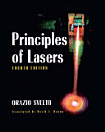Principles of Lasers
มิ.ย. 2013 · Springer
eBook
376
หน้า
reportคะแนนและรีวิวไม่ได้รับการตรวจสอบยืนยัน ดูข้อมูลเพิ่มเติม
เกี่ยวกับ eBook เล่มนี้
This book is the result of more than ten years of research and teaching in the field of quantum electronics. The purpose of the book is to introduce the principles of lasers, starting from elementary notions of quantum mechanics and electromagnetism. Because it is an introductory book, an effort has been made to make it self contained to minimize the need for reference to other works. For the same reason; the references have been limited (whenever possible) either to review papers or to papers of seminal importance. The organization of the book is based on the fact that a laser can be thought of as consisting of three elements: (i) an active material, (ii) a pumping system, and (iii) a suitable resonator. Ac cordingly, after an introductory chapter, the next three chapters deal, respectively, with the interaction of radiation with matter, pumping processes, and the theory of passive optical resonators.
ให้คะแนน eBook นี้
แสดงความเห็นของคุณให้เรารับรู้
ข้อมูลในการอ่าน
สมาร์ทโฟนและแท็บเล็ต
ติดตั้งแอป Google Play Books สำหรับ Android และ iPad/iPhone แอปจะซิงค์โดยอัตโนมัติกับบัญชีของคุณ และช่วยให้คุณอ่านแบบออนไลน์หรือออฟไลน์ได้ทุกที่
แล็ปท็อปและคอมพิวเตอร์
คุณฟังหนังสือเสียงที่ซื้อจาก Google Play โดยใช้เว็บเบราว์เซอร์ในคอมพิวเตอร์ได้
eReader และอุปกรณ์อื่นๆ
หากต้องการอ่านบนอุปกรณ์ e-ink เช่น Kobo eReader คุณจะต้องดาวน์โหลดและโอนไฟล์ไปยังอุปกรณ์ของคุณ โปรดทำตามวิธีการอย่างละเอียดในศูนย์ช่วยเหลือเพื่อโอนไฟล์ไปยัง eReader ที่รองรับ








